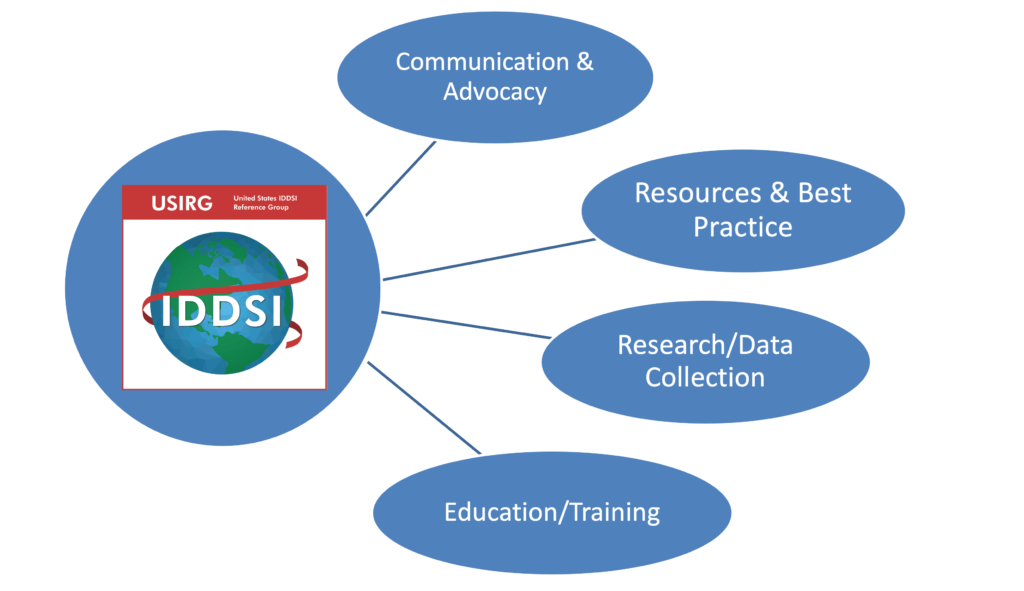7 IDDSI Updates
by Karen Sheffler, MS, CCC-SLP, BCS-S of SwallowStudy.com
Introduction to IDDSI Updates
Did you know that well over 50 nations around the world have started to implement the International Dysphagia Diet Standardisation Initiative (IDDSI). This has been a global consensus on foods and drinks for people with difficulty swallowing (dysphagia). The vision started in 2013. IDDSI is for improved patient safety (aka, risk mitigation) for all ages, all cultures/languages, and in all care settings (including people at home). We will all finally be using the same terminology for the different solid food levels and drink levels (see framework on IDDSI.org and in image below). Imagine, no more guess work by the skilled nursing facility when selecting a diet for your loved one. The diet texture will be already identified based on the person’s swallow study and labeled by the hospital (e.g., Soft & Bite-Sized, Level 6 and Mildly thick liquid, Level 2) who will communicate with the same diet terminology as the nursing facility down the street.
Nations around the world have been forming work groups (aka, reference groups) to foster IDDSI implementation. It is inspiring to have global IDDSI meetings with large nations like Brazil, Mexico, Canada, and China, as well as smaller nations such as Iceland, Myanmar, Azerbaijan, Portugal, and the United Arab Emirates. It truly is a global wave of standardization of food and liquid textures (aka, dysphagia diets).
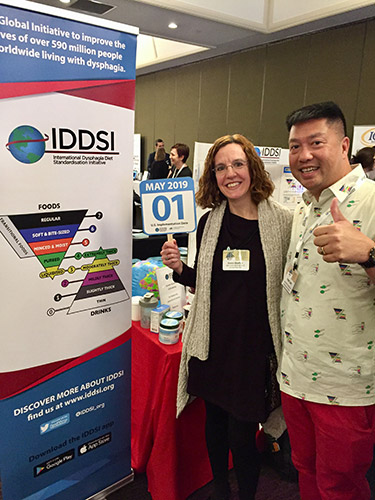
IDDSI launched in in the USA per ASHA and the AND in May 2019. Then COVID-19 hit. Where are you now with IDDSI implementation?
The American Speech-Language and Hearing Association (ASHA) along with the Academy of Nutrition and Dietetics (AND) declared May 1, 2019 as the official launch date for IDDSI in the USA. Then COVID-19 hit! Many facilities that were deep in the middle of IDDSI implementation were derailed. However, as of October 2021, The Academy of Nutrition and Dietetics announced that IDDSI will be the only texture-modified diet recognized in the Nutrition Care Manual NCM®. The National Dysphagia Diet (NDD) and associated resources will no longer be included, supported, or recognized in the NCM® past October 2021.
United States IDDSI Reference Group (USIRG)
In the United States, the United States IDDSI Reference Group (USIRG) formed in early 2021 to support implementation across the nation with a large group of active volunteers who are generating resources and answering questions.
I am on the USIRG’s Communication & Advocacy and Resources & Best Practice work groups. We have been busy! Regarding resource development, we are curating and creating resources that are US-specific. We have been trying to gather resources that facilities have already created. We hope that organizations/facilities around the nation are keeping up with IDDSI updates and sharing with other facilities. It would be nice to not have everyone re-invent the wheel. However, some proprietary regulations in some healthcare organizations have prevented faster dissemination of those resources and handouts. If you are able to share with others around the nation, please contact usa@iddsi.net. You can also contact usa@iddsi.net to ask questions and provide ideas on what resources need to be developed.
Feel free to join one of our 4 committees as seen here:
7 IDDSI Updates & Encouragement to Connect
1. USIRG IDDSI Chart of Many Resources
Go to —> https://iddsi.org/around-the-world/united-states
- USIRG IDDSI Tutorials & Trainings (see this section of the USIRG chart): We have IDDSI 101 and 201 PowerPoint Videos for Food Service Workers & Caregivers, Healthcare Professionals, and Administrators. The links in the USIRG chart bring you to a YouTube video where the USIRG speaker guides you through the PowerPoints.
- IDDSI 101s start with easy and quick introductions to IDDSI.
- IDDSI 201s train the IDDSI Testing Methods across the whole framework. There is a 201 for Food Service Workers and a more in depth 201 for Healthcare Workers (RDNs, CDMs, SLPs, etc.).
- USIRG Best Practice IDDSI Terminology (Powerpoint): It is so important to use IDDSI approved terminology. This PowerPoint teaches how it is best practice to use two identifiers when discussing or writing about the IDDSI levels. (We use two identifiers with our patients of name and date of birth and/or medical record number, so IDDSI does the same to avoid confusion). For example: Mildly Thick, Level 2; Minced & Moist, Level 5; Soft & Bite-Sized, Level 6. We cannot change these descriptive labels. For examples, a Minced diet definitely needs Moist attached to it to make it safe. Level 6 needs to be written as “Soft & Bite-Sized” as both of those terms appropriately describe how that diet can mitigate (reduce) a choking risk; the food needs to pass the Fork Pressure Test for “soft” and needs to pass the bite-size of 1.5cm to not block an airway (see Testing Methods details here in English). This Terminology PowerPoint also provides the 3-character approved abbreviations for your computer systems.
- Please see the IDDSI Framework & Testing Methods in many languages here.
- Competencies: It is important to document the training that you and your coworkers are undertaking in IDDSI. We have completed the competency quizzes for the 101 and 201 trainings. For example, see the 101 Competencies for Food Service Workers & Caregivers and other competencies in the USIRG chart.
- We would love it if facilities would share their ideas and forms for staff competencies (i.e., how to demonstrate staff trainings).
- One idea that some facilities have used is to use the IDDSI Audit Tools for each IDDSI level and turn them into staff training sheets for demonstrating the IDDSI Testing Methods for each level.
- Check out the Frequently Asked Questions section (in the USIRG chart). Have you ever wondered about Jell-O, sauces and gravies, and how to manage writing exceptions on a case-by-case basis outside the IDDSI framework to meet the goals and wishes of the people you serve?
- Current USIRG work group projects include:
- Making the IDDSI Patient Handouts more user friendly to the United States audience. (They were written with some British-English vocabulary, such as Lollies, Biscuits, and Crisps!).
- Cataloguing over 500 articles into an IDDSI literature evidence table.
I will keep you all posted on IDDSI Updates & new links above (last edit November 2024 after IDDSI website updates).
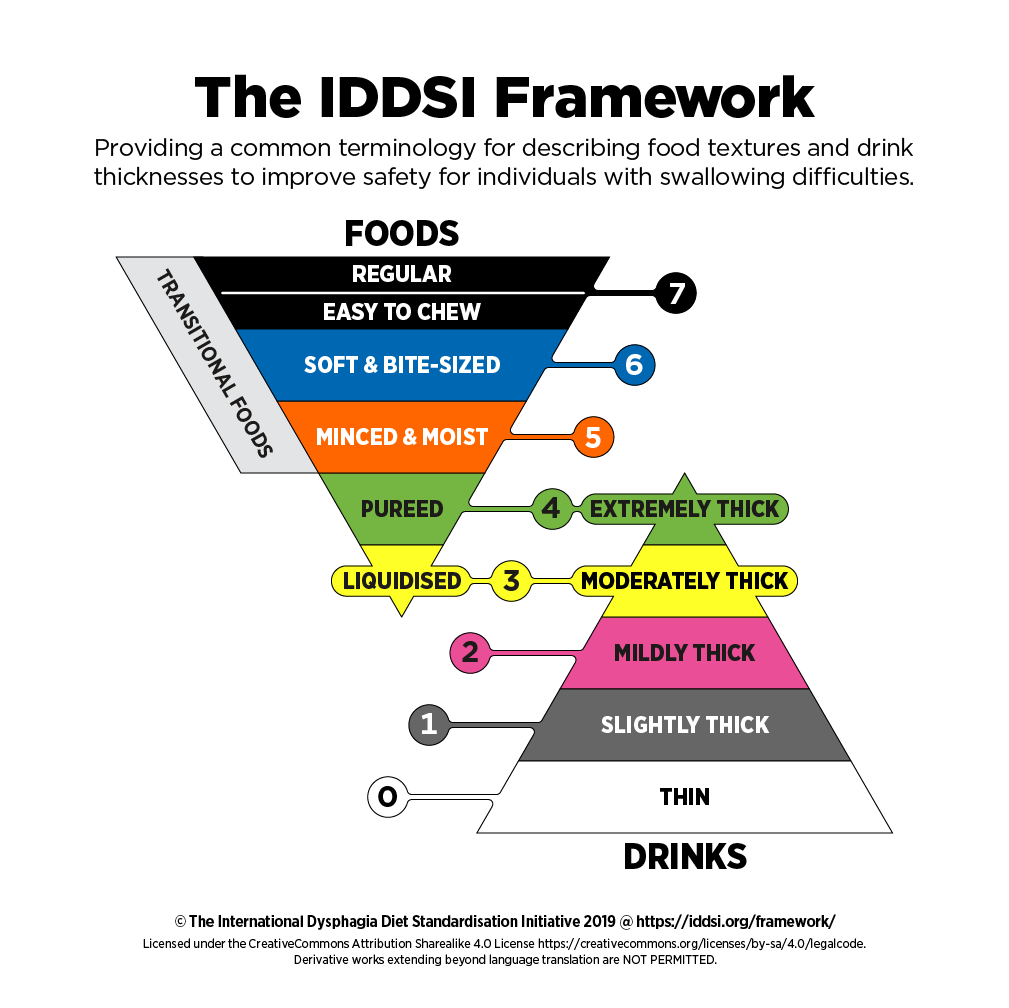
Readiness for IDDSI Updates starts with knowing the IDDSI framework with pyramids for solids and drinks/liquids, along with the sidebar for transitional foods. Each IDDSI level has a name, color, number and triangle icon. Use at least two identifiers when talking or writing about IDDSI levels, such as Mildly Thick Liquid, Level 2.
2. Hormel Health Labs‘ Resources:
- Hormel Health Labs’ (HHL) Full IDDSI Training Series: https://www.
hormelhealthlabs.com/ resources/for-healthcare- professionals/in-service- training-series-videos- information/ - Request a free test kit
- Download supplementary handouts for each course
- Download and watch 5 video courses.
- Disclosure: I created and recorded the 2nd and 3rd webinars on food quality control and beverage quality control, giving descriptions and testing methods for each solid and liquid level. I was given an honorarium for recording these courses, but I do not make any commission on this or on any products by Hormel Health Labs.
- Competency quizzes and learning checklist that go with these trainings. Obtain these after you sign up, making a user name and password. https://www.hormelhealthlabs.
com/resources/for-healthcare- professionals/iddsi- competencies-training/. This 4-tiered competency takes a person from the basic introductory level through an advanced level to become an IDDSI champion in your facility or organization.
3. SimplyThick.com Resources & Support for IDDSI Funnels
- Follow SimplyThick inventor John Holahan on tiktok (@SimplyThickJohn) when he posts on: SimplyThick mixing videos, IDDSI lessons, and food demonstrations.
- IDDSI Funnels: Backed by years of science, the IDDSI Funnels are designed specifically for the IDDSI Flow Test and come easily marked with IDDSI Framework Levels indicated on the side. The innovative funnel top is designed so you can pour your test sample directly into the funnel without the need for another syringe. Re-usable, dishwasher safe, and recyclable.
- Thank you Simply Thick for helping IDDSI with distribution of these IDDSI-invented 10ml funnels for the IDDSI Flow Test. They got these out to the public at cost during 2022. They are still available on SimplyThick, but now IDDSI has these mass produced and distributed world-wide –> see below.
- IDDSI Funnels Purchase – Initially the only place to buy them was:
IDDSI Funnels Now Distributed by IDDSI
-
- Purchase: See IDDSI’s website under the Resources section for where and how to purchase Funnels.
- That link contains: Instructions for Use (IFU), IDDSI Flow Test video, and reference cards.
- IDDSI Flow Test Instructions with SYRINGES (YouTube)
- IDDSI Flow Test – Flow Tests Instructions with FUNNEL (YouTube)
- Check out Flow Test cards in different languages
- NEW Flow Test Cards using the Funnel: Large folded table reference card and the Pocket card of the IDDSI Funnel Flow Test.
- Instructions for Use (IFU) for Funnel
- Purchase: See IDDSI’s website under the Resources section for where and how to purchase Funnels.
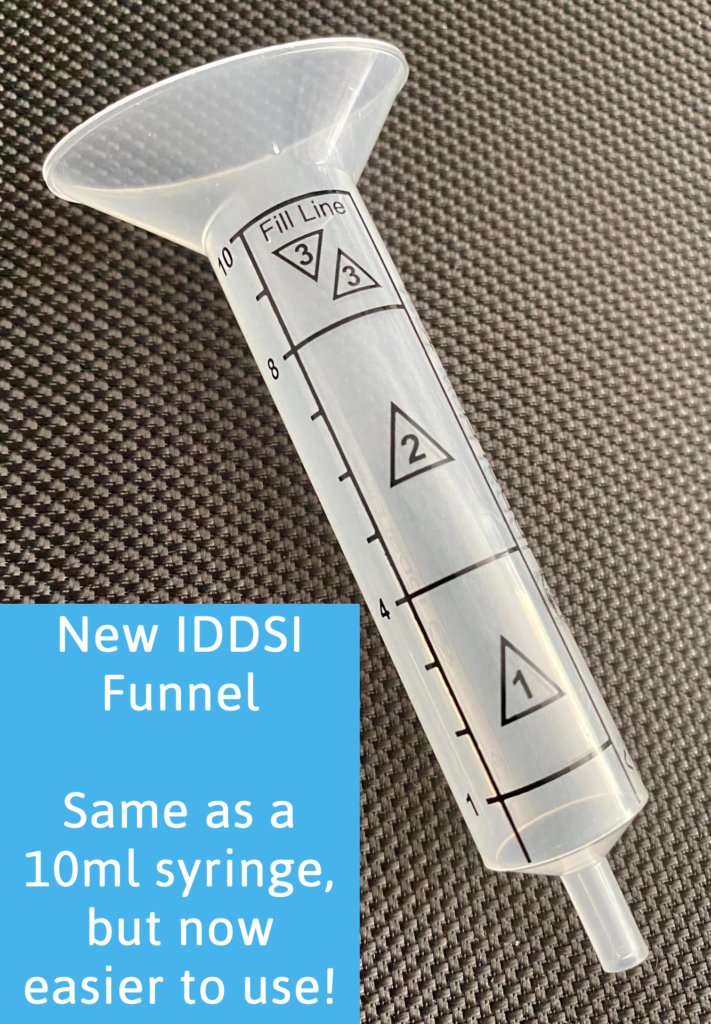
A big IDDSI Update is this IDDSI Funnel for the IDDSI Flow Test. Similar to the 10ml syringe, but the top is wider for easy pouring into the syringe. Markings on the side make measuring liquids clear for testing IDDSI levels 1, 2, 3.
4. Food Scientists & Chefs Train IDDSI:
a. IDDSI Webinar on Myths & Truths
Peter Lam (IDDSI co-chair) hosted this myth busting online event with expert rheologist and IDDSI Testing guru Dr. Ben Hanson and dysphagia culinary and foodservice specialists Preston Walker and James Ball from Oak House Kitchen. The live panel discussion will cover the science involved and the culinary know-how behind making food for the IDDSI Framework. Go to IDDSI’s YouTube Link: https://youtu.be/mQ75b7sKxtU.
b. More IDDSI & Oak House Kitchen Webinars
- The Science Behind IDDSI: Dr. Hanson, IDDSI Board Director, is joined by Peter Lam (IDDSI Co-Chair), and discusses the science and methodology behind IDDSI testing methods
-
Myths and Truths about Modifying Foods for IDDSI levels. Preston Walker and James Ball, of Oak House Kitchen, have been training healthcare catering for over 10 years. Their current focus in this field is on the transition to the IDDSI standards and have been working on how best to achieve this.
c. Rubiconfoods.com
Some chefs and dietitians from the USIRG and Rubicon Foods have teamed up with Pineapple Academy, LLC to make quick videos on how to prepare foods and drinks IDDSI-style. To see examples of how to puree, vacuum seal, shape and plate meats to prepare a perfect Pureed, Level 4, check out this free sneak peak to their trainings: www.rubiconfoods.com/iddsi/.
5. E-Bites & IDDSI website: Stay Informed of Any IDDSI Updates & Events
- Sign up for IDDSI Global’s e-bites / newsletters
- Check out the e-bites for the USIRG at the bottom of our resources chart here: https://iddsi.org/United-States.
- Also at the bottom of that chart are email contacts for each of the four USIRG committees.
- Again, see the FAQ section in our USIRG chart with answers to burning questions about 1. Exceptions: Bread and Mixed Consistencies, and 2. Sauces, Gravies, and Condiments. Keep your questions coming!
- Follow IDDSI on social media: Twitter, Instagram, LinkedIN
- Follow IDDSI on YouTube for great food and drink testing videos and many webinars. These cover IDDSI across all ages and the continuum of care. These will help you train your staff. Many of these food and drink testing demonstrations have been translated into other languages. My favorite one to add to training PowerPoints is the beginning of this one that covers some of the choking dangers of bread: https://youtu.be/W7bOufqmz18
- Download the IDDSI app. You can even use this in a person’s home to train the person with dysphagia and their caregivers. Once the content is downloaded, you can view it without the use of wifi.
- Check out popular IDDSI training posters.
- IDDSI has been translated into 20 languages so far. See available translations and how you can help expand this list.
6. Keep Asking Questions & Clear Up Myths:
Is IDDSI Mandatory? Do I have to Change? Can you give me a list of IDDSI approved foods?
I will answer these questions with slides from my PowerPoints that answer them in a pretty way! Here is a link from IDDSI.org, sharing about how IDDSI is now the only professionally-recognized standard of care.
Feel free to use any images or let me know if you need PowerPoint content. IDDSI’s mission has always been to make content free and accessible around the world.
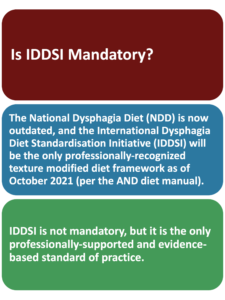
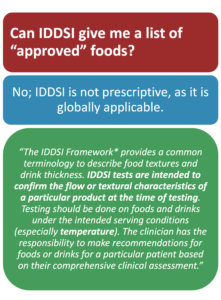
Clear Up Myths
We need to clear up common confusions and misunderstandings about what IDDSI is with these IDDSI updates:
-
-
- IDDSI does not mandate what patients are or are not allowed to have. That is a decision to be made by the whole medical team, of which the person with dysphagia is the driver. IDDSI pairs with person-centered care well.
- IDDSI does not mandate what you as a dysphagia clinician or registered dietitian recommend for the person with dysphagia.
- What mandates care are the decisions made by the person, considering their goals of care, wishes, and preferences.
- Good documentation supports those decisions.
- See USIRG’s new FAQ section that addresses exceptions to the IDDSI Framework, especially in the bread FAQ.
- IDDSI is a set of standardized labels, descriptors and definitions for foods (regular through puree) and drinks (thin liquid through extremely thick).
- IDDSI provides testing methods to prepare and test foods to standardize what is potentially easier and safer for an individual with difficulty chewing, swallowing or clearing foods through the mouth, throat and esophagus.
- IDDSI is a tool to help you clearly discuss options related to consuming foods and liquids.
- We finally are all talking the same language, understanding what we mean by “soft,” “puree,” “thick liquid,” “easy to chew,” and more.
- Old diet labels (such as “mechanical soft”) have no standard definitions and have been the source of numerous choking deaths around the country.
- Old diet systems (such as National Dysphagia Diet) were too subjective and did not have testing methods or descriptors based on evidence.
- Read more on Why IDDSI? in this mission statement found in our USIRG resource chart.
- Clinicians have a conversation with the person (and/or healthcare proxy if the person is deemed unable to make complex decisions).
- IDDSI does not dictate what is best or safest for the person. One cannot prevent aspiration and/or choking 100% of the time. We offer options to mitigate risks, though.
- Clinicians use their clinical judgement, expertise, evidence-based practice, guidance from comprehensive dysphagia evaluations (that may include instrumental evaluations) to make recommendations.
- Clinicians provide options (aggressive through palliative, as appropriate). We provide education, counseling, and potential prognostic information (i.e., are you having difficulty swallowing, what can we do about it, and how long will it take to get better?). Sometimes we recommend diet modifications temporarily for very acute problems while waiting for further testing, resolution of symptoms, and/or for a targeted therapy program to hopefully improve the swallowing and mealtime success. Sometimes diet modifications are needed more long-term. Each person is an individual.
- The medical team, which includes the person with dysphagia, discusses and considers options. It is the person (or healthcare proxy) who makes the informed decision on care without coercion of waiver forms (which have been used when a person does not agree with the recommendations of a healthcare provider, who is not using person-centered care).
-
7. Connect & Volunteer
- If you are interested in volunteering with USIRG, find emails at the bottom of the USIRG chart.
- International Special Interest Groups and contact emails:
- Culinary: CulinaryIRG@iddsi.net
- Food Science: FoodScienceIRG@iddsi.net
- Pediatric: PedIRG@iddsi.net
- Being a part of IDDSI is being a part of a global consensus wave of standardization for patient safety! Exciting collaborations happen across countries, such as:

- “Porridge Around the World” – See work from countries in Asia:
- IDDSI in Iceland. I met Fríða, a dietitian from Iceland, who is starting the IDDSI work group in Iceland. Here we are showing off the new IDDSI Funnel that I brought over, along with many BD syringes and IDDSI pens!
More IDDSI News:
IDDSI Updates on Funnels as of March 2023
To reiterate and emphasize, you can now purchase the funnels on the IDDSI website. Go to IDDSI.org –> Resources Tab –> Funnels (or https://iddsi.org/resources/funnels). The link is on that page, along with pdfs for Instructions For Use, Testing Cards, and Instructional Videos. Thank you IDDSI!
IDDSI’s International Reference Groups Gathered at #WDS2023 & #DRS2023

The International Dysphagia Diet Standardisation Initiative (www.IDDSI.org) has developed Reference Groups around the world to assist with IDDSI implementation and translation. We have been meeting within our United States IDDSI Reference Group (See USIRG’s country specific content) since 2020. Now, over 50 countries around the globe have created IDDSI Reference Groups. It has been so inspiring to attend virtual meetings for over a year now, joining all these Reference Groups together to support one another. In March 2023, we had a combined meeting in San Francisco of the World Dysphagia Summit (WDS) and the Dysphagia Research Society (DRS) Annual Meeting.

It was exciting to finally meet our colleagues in person from Reference Groups from many different countries, such as: Brazil, Chili, Colombia, Mexico, Canada, Japan, Austria, Germany, Netherlands, Australia, our newest representative from Kuwait, and more.
Summary on IDDSI Updates
It has been a global wave of consensus in a standardized framework. We now all “speak the same language” when it comes to labeling, defining, describing, and testing all levels of solids and liquids (from regular solids through all the dysphagia diets and thin liquids through all 4 levels of thickness).
Please note: IDDSI is a standardized tool that in no way dictates or mandates. The clinician still uses clinical skills to give rationale and make recommendations. The medical team (of which the person is in the center) uses informed decision making. IDDSI does not promote diet and liquid modifications, but the person with dysphagia and the rest of the medical team finally has a defined framework to allow for clear communication of diet options when using a person-centered care approach. To reiterate this point, the USIRG has created a person-centered care statement:
USIRG’s PERSON-CENTERED CARE (PCC) STATEMENT
The IDDSI Framework cannot change, but the diet order can be individualized. Person-centered diet orders specify an individual’s needs within and outside the IDDSI Framework. The medical team works in collaboration with the person’s wishes, preferences, goals of care, and individual abilities. Risks and benefits may be addressed in the informed consent process. Clear orders, communication, and documentation are key to person-centered care.
The IDDSI Framework with Detailed Definitions and Testing Methods published in many languages finally make this communication process clear and easy to educate people and caregivers on the all the treatment options.


